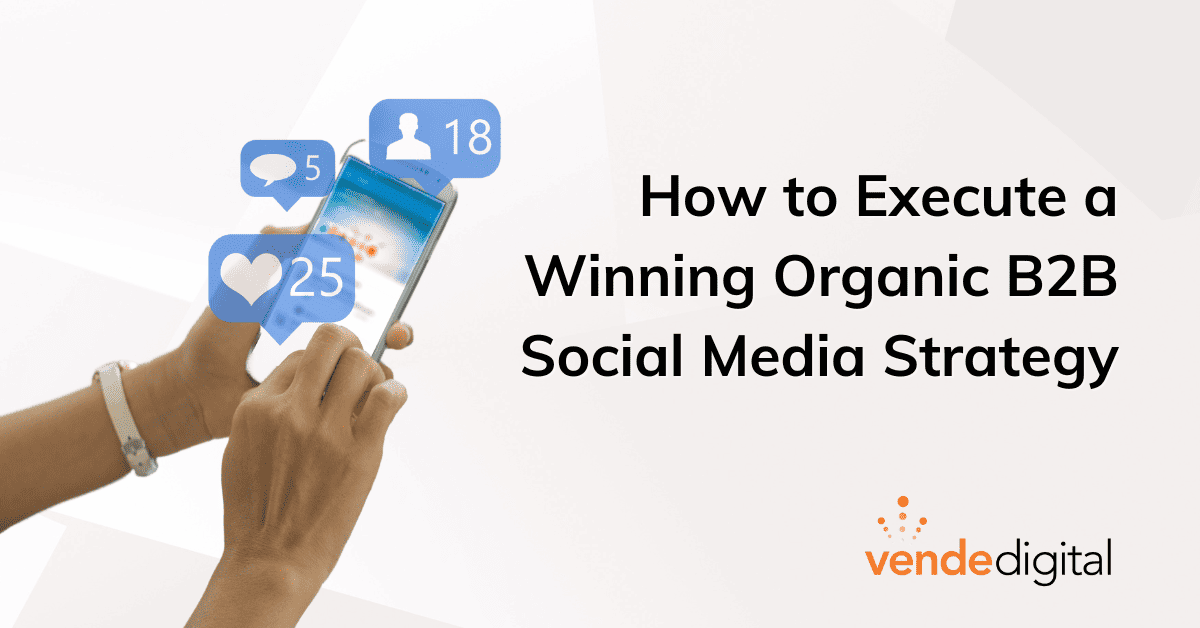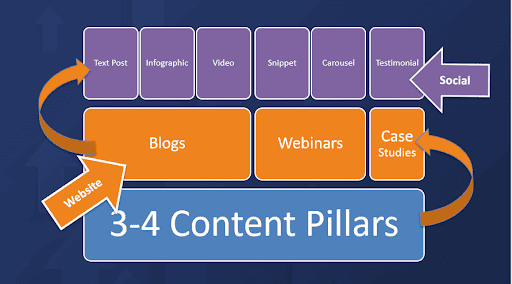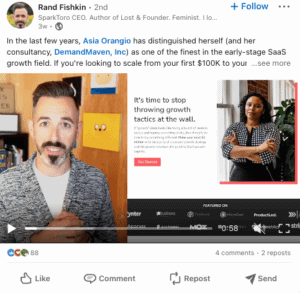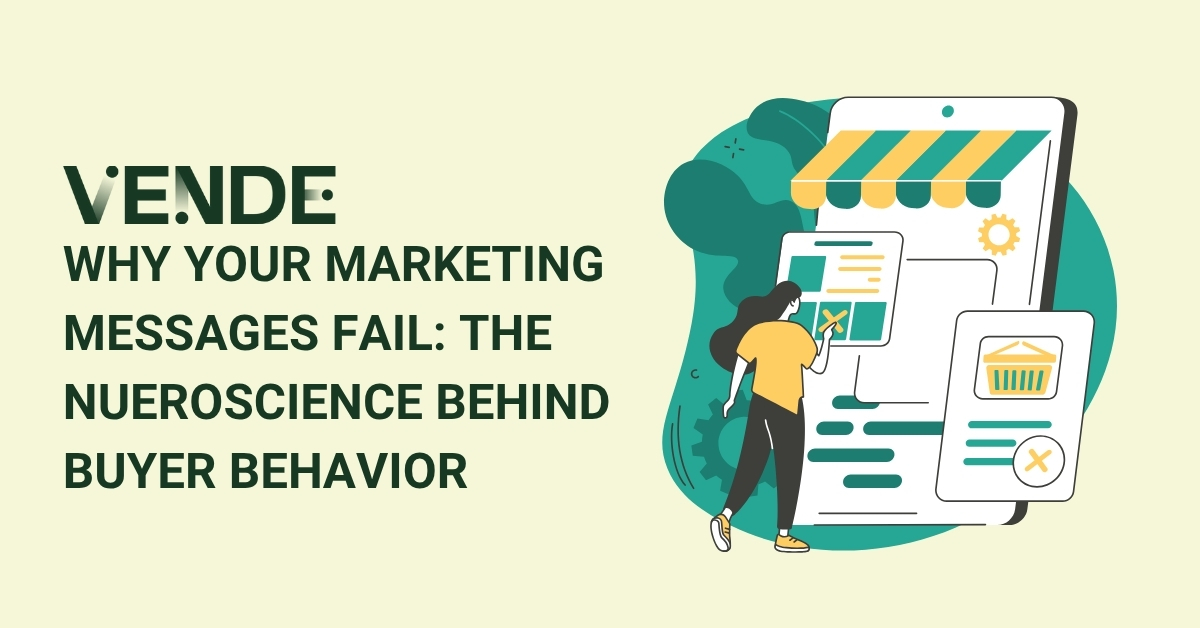
How to Execute a Winning Organic B2B Social Media Strategy
An organic social media strategy is key to achieving greater online presence, brand awareness, and visibility. And it should most definitely be part of your overall B2B demand generation marketing strategy.
It is this organic content that will help you establish a connection with your audience in a more natural way. And it will ultimately support your paid advertising campaigns by developing trust, community, and credibility in public.
This article will cover how to execute your organic B2B social media strategy. If you don’t have a clear social media strategy yet, you may be interested in reading, How to Build a Winning B2B Social Media Marketing Strategy.
What are the Benefits of B2B Organic Social Media Marketing?
B2B buyers use social media channels to connect with their peers and stay informed about industry developments. But they also use social media to learn about products and solutions from people they trust.
When you execute an winning organic B2B social media strategy, you will:
- Create awareness and visibility for your business.
- Establish your business as an authority in your field.
- Create an opportunity to engage with your prospects.
And as a result, your company will strengthen its brand, reach more people, drive more website traffic, and generate better quality leads.
Why B2B Companies Struggle to Grow on Social Media?
One mistake B2B companies make is that their content is not in sync with their company's overall marketing objectives and therefore fail to gain any real traction.
This is why many companies give up and consider organic content creation a waste of time. B2B companies fall into the trap of overpromoting their products and services rather than building trust and authority with their audience.
The fact is that less than five percent of potential customers are ready to buy. Posting educational content rather than promotional content will help build awareness, interest, and authority.
Publish Strategic Content using Content Pillars
Focus is the key to publishing the right content on your social media accounts. You must be clear on which topics will offer the most value to your audience, prospects, and customers.
These topics are your content pillars and will help guide your content production. Choose topics that align with your strengths and are vital in helping your customers solve the problems they are facing.
A mistake many B2B companies make is focusing on too many topics, leading to their message's fragmentation. They focus on industry news or other areas that fail to educate their prospects about what they do and how they can help.
Limit the number of content pillars to three or four to stay focused, or you will risk diluting your message and confusing your buyer.
How to Build a Content Flywheel?
Once you have chosen the right content pillars, you can begin to build your long-form content. This could be blog posts, webinars, or case studies.
And it's this long-form content that needs to live on your website.
For example, Vende Digital holds regular webinars to educate our prospects and customers about B2B marketing. In these sessions, we share how they can solve marketing problems and improve their results.
Those webinars are then repurposed into content like this long-form blog post. But they are also uploaded to YouTube and available on our website.
Now you will want to create micro-content from your long-form content to use on social media.
This micro-content will be snippets from your long-form content and then optimized for each social channel in the appropriate format.
This will help make consuming your content easier for your audience and encourage greater buyer engagement.

Why Do You Need to Align Your Content Marketing Teams?
Another mistake companies make is that the people or teams running content marketing are not always the same people managing their social media channels.
This can result in the best long-form content on your website gathering dust while your social media manager posts about your company picnic or employee’s anniversary.
It's not to say those things are not important. You need to share the culture of your company on social media. But strategically, you also need to get your high-quality pillar content out in front of your buyers to position yourself as an authority in your field.
The Objective of Organic Social Media Marketing
The ultimate goal of organic social media marketing is to attract your buyers' attention and drive them to your website. You do this by using content as the bridge between the two.
Another way to frame this is by comparing social media to a cocktail party.
There are all these people gathering at a public venue. If you decide to join the party, you will be able to meet all these new people and share conversations with them. But there will be people who like what you have to say and others who don’t.
Simply being visible is going to attract interest as people meet you. There may be many that become your friends. And once you’ve become friends, you will want to invite them around to your house or, in this case, your website.
How to Boost Reach on your Company Pages?
This is probably the most asked question we get from people at our webinars and for a good reason. The bad news is that you will not get much organic reach or engagement on your company page.
LinkedIn is going to deliberately limit your reach.

LinkedIn and all social media platforms want businesses to pay to get more visibility. This is how they make their money. This is why you will struggle to grow and gain both followers, and engagement unless you invest in paid advertising.
But there is good news.
Increase Visibility with Employee Advocacy
There is a strategy to help you promote your company without investing in paid advertising. And that strategy is to use social media influencers. But not the kind of influencers you may think.
You already have a whole organization full of great people. Your influencers are working for you right now, from the C-suite to your subject matter experts, your sales reps, and everyone else at your company.
If you want to increase your organic reach, which needs to be a part of your overall social media marketing strategy, encourage your employees to be active.
You want them to be on social media humanizing your content and building a community around your business. And to be engaging with prospects and buyers online.
At Vende Digital, we use this exact strategy to help us reach more prospects, and we have seen our clients achieve incredible results with this approach.
Two Reasons Personal Profiles are Better
1. Personal Profiles Get More Organic Reach
The majority, 99% of the people on LinkedIn, never post anything. They have a LinkedIn profile. They might go onto LinkedIn occasionally, but they only scroll the feed; they don’t like, comment, or post anything on their profile.
If you encourage your employees to start creating content and sharing their points of view, they will immediately become part of the one percent of active content creators
.
By humanizing your company's content with their own perspectives, they are now amplifying your message above and beyond your company page.
2. Personal vs. Business Profiles
One thing that many companies don’t realize is that LinkedIn has two different algorithms for personal and business profiles.
When you share something on a personal profile, you will gain more reach and engagement than anything you post on your company page.
For example, here at Vende Digital, we know that if all our employees share on social media, it can create more opportunities to reach people.
And the same goes for your business. Having all of your employees engaged on social media will immediately amplify and increase your overall reach on LinkedIn.
But understand there is no simple trick to getting massive organic reach. It takes time and investment from you and all your staff to truly get the results. But it can be done and is a highly effective strategy.
Download our PowerPoint template to communicate with the people in your company about why they need to be engaging in social media.
The C-Suite and B2B Social Media
Getting founders involved in social media can be a great way to build authority and credibility for your organization. As a founder, I can say that being involved in social media has been key to our success.
When I talk to C-levels, especially CEOs, they think social media wastes time.
But one thing I've learned is that they generally love to talk about what they do, share what they know, and love to give speeches.
Here's how I help give them perspective on the value of social media.
I’ll say, “Did you know that if you engage on social media, it's like giving a keynote speech to your best prospects and customers every time you post.”
That will usually get their attention, and they generally respond, “That’s interesting; tell me more.”
If you struggle to convince your CEO or any of the C-suite executives to commit to social media, try to give them perspective on the value of engaging on social media.
Once they recognize how it can enhance both the business and their reputation, they may be more open to embracing it.
Rand Fishkin is an excellent example of a CEO or founder utilizing social media. He originally founded SEOMoz years ago but is now the founder of SparkToro.

One of the things he does really well is sharing short videos showing how to use his product and how it helps you find where your audience is on the web.
He does this regularly on social media, which gets excellent engagement, and many people find what he shares incredibly useful and interesting.
This builds both credibility and authority for both the company and the founder.
What to ask before publishing a social media post?
Writing social media posts can be challenging, but there is a simple way to decide whether your posts will add value to your business, customers, or prospects.
Here are four simple questions to ask before publishing a post:
1. Does this pass the me versus you test?
Is this post all about you, or is it about your customer? If it doesn’t speak about them, they will probably lose interest.
2. Will this post help your customer?
Is this going to help your customers, and is it insightful? Your post should offer at least one thing to help your customer.
3. Does this post create momentum?
Will this post help them understand their problem and build momentum to solve it or overcome their challenges?
4. Is this post any good?
Step back and honestly look at your post and ask yourself, “is this a good post?” If somebody you know reads this post, would you be proud of it?
As you post more content, you will be able to gain insights into the performance of your posts as people engage with you. Some will be a success, and some will flop.
But the key to growth on social media is long-term consistency in both publishing content and engaging with the community.
Key Takeaways for Executing a Winning Organic B2B Social Strategy:
Organic social media marketing should be part of your overall social media strategy as it can create massive visibility and influence for your business.
It can be done at scale if employees contribute to creating content and engaging on social media.
Key Points:
- Align your social media content with your marketing objectives.
- Use content pillars to maintain consistency and focus.
- Use your website as a library for all your long-form content.
- Create micro-content for social media from long-form pieces.
- Use content on social media as a bridge to your website.
- Amplify your reach by leveraging your employees as influencers.
- Encourage the C-Suite to share posts and engage to build authority.
- Consider the value of your posts before publishing.
- Consistency is key to long-term success.
How Can We Help?
Finding the time to build and execute an organic B2B social media strategy can be daunting. At Vende Digital, we help B2B organizations like you to develop sound strategies to grow on social media.
Are you tired of struggling on your own?
Schedule a complimentary discovery call with our team to see how we can help you structure a unique social media marketing plan that gets results.







